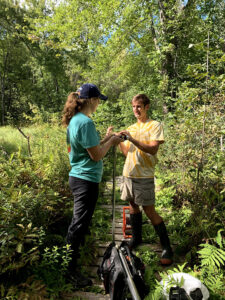
Investigating Maine’s Indigenous fire pre-history.
Expedition Dates: August – October 2021
Expedition Field Team Members:
Madi Landrum, Kit Hamley, Alessandro Mereghetti, Noa Buzby, Tommy Thelander, Meghan Spoth, Jacquelyn Gill, and Andrea Nurse
Expedition Funding:
Churchill Exploration Fund. Thank you Dan and Betty for making this field season possible.
Other Acknowledgements:
Thanks to Acadia National Park and Hirundo Wildlife Refuge for allowing us to conduct this field work, and the UofMN CSD Facility for initial core description.

Now that the sediment has been collected, we will analyze the pollen, charcoal, and fossils, along with other proxies, in the lab to reconstruct what the surrounding forests looked like going back to the deglaciation of Maine. Combined with charcoal and climate information, these proxies will show if people used fire as a tool to shape the forests and cultivate food crops, or if fires had alternate ignition sources.

Significance
Though fire is not considered to be an important process in the Northeast, with climate change exacerbating existing environmental issues, it is becoming an increasingly dangerous threat. In the summer of 2020, there were over 900 high-intensity fires in Maine due to drought and increased eco-tourism. This study seeks to understand low intensity fires and will inform conservation and management practices. Such fires clear underbrush and snags, reducing the fuel load for uncontrolled fires. This would make Maine’s forests safer while also reducing tick populations by burning shrub species that foster these disease vectors. Cleared underbrush would improve forest health by reducing canopy competition and eliminating weaker diseased trees. All of these benefits could increase timber quality and forest health, boosting two of the state’s major industries during a time of economic uncertainty. This research also aims to contribute to the Native American Graves Protection and Repatriation Act (NAGPRA) by providing supporting evidence of long-term tribal habitation of the Wabanaki people.




